New Export Logs
Export logs using the new Export Logs interface.
Note
This page covers the documentation for the new/advanced Export Logs interface that was launched in Webex Connect release v5.6.3 in April 2022.
The Export Logs page is divided into the following two tabs and sections within:
- Download / Export: You can download or export outbound logs, inbound logs, outbound webhooks failed notification logs, and view recently downloaded and exported logs. You can download Export Logs with the following methods:
- Schedule Export: You can schedule the export of logs set at the desired frequency and duration.
Download / Export Logs
This tab allows you to download export logs for inbound and outbound transactions. The tab also allows scheduling a one-time logs export to a S3 or SFTP location.
Note
- The time taken to prepare the zip file for download depends on the number of records in the file. In the case of a large number of records, it can take up to 30 minutes.
Limitations
The multi-select option of Export Logs is not supported in the Azure environment.
Direct Download
You can directly download the logs on to your local system by using one of the two methods below.
- To download outbound logs, select a Service, a Channel, the required Period, and then click Download.
- To download inbound logs, select a Number or App, the Channel Events, the required Period, and then click Download.
Here are the various statuses that appear in relation to the options selected, while performing the download operation:
- Pending: After you click the Download option, a new entry is created under the Recent Downloads/ Exports section, indicating the status of download as 'Pending'. In a few seconds, the status changes to 'Preparing for download'.
- Ready for download: After the file is ready to download the status changes to 'Ready for download' and the download icon appears in the Status column against the entry. Click the download icon to start the download of a .zip file (containing the transaction logs) to your local system.
- No Records: If the log does not have any records, the status changes to No Records.
- When the multi-select option is enabled: If the multi-select option of Service, channels, Number or app, and channel events is enabled for your tenant, you can select multiple services and channels for Outbound logs or multiple apps, assets, or numbers and channels for Inbound logs. If the multi-select option is enabled, you will be allowed to download up to 100 million records per download request.
- When the multi-select option is not enabled: If the multi-select option is not available for Service, channels, Number or app, and channel events, then you can download up to 10 million records per selection by using the UI-based download option.
Time taken for large records
The time taken to prepare the .zip file for download depends on the number of records in the file. In the case of a large number of records, it can take up to 30 minutes.
- Records in the Recent Downloads / Exports: A list of recent 20 downloads appears under the Recent Downloads section. For each of the log files, this section shows the system-generated name of the download action, download type (Download via URL is a direct download to the local system, exported to S3 is a one-time export to S3), number of records within the log files, and the timestamp at which the log file download was initiated.
In the case of direct download for Outbound logs and Inbound logs, the naming convention or format is Logs-timestamp-UniqueID,. Here's an example for an Outbound file - Logs-2024-05-30T200710.010-ea79ea7b-f65d-4c67-9bd8-f8662715b1b5.zip.
Channels not supported
Export Logs capability is not available for Instagram and Google Business Messages.
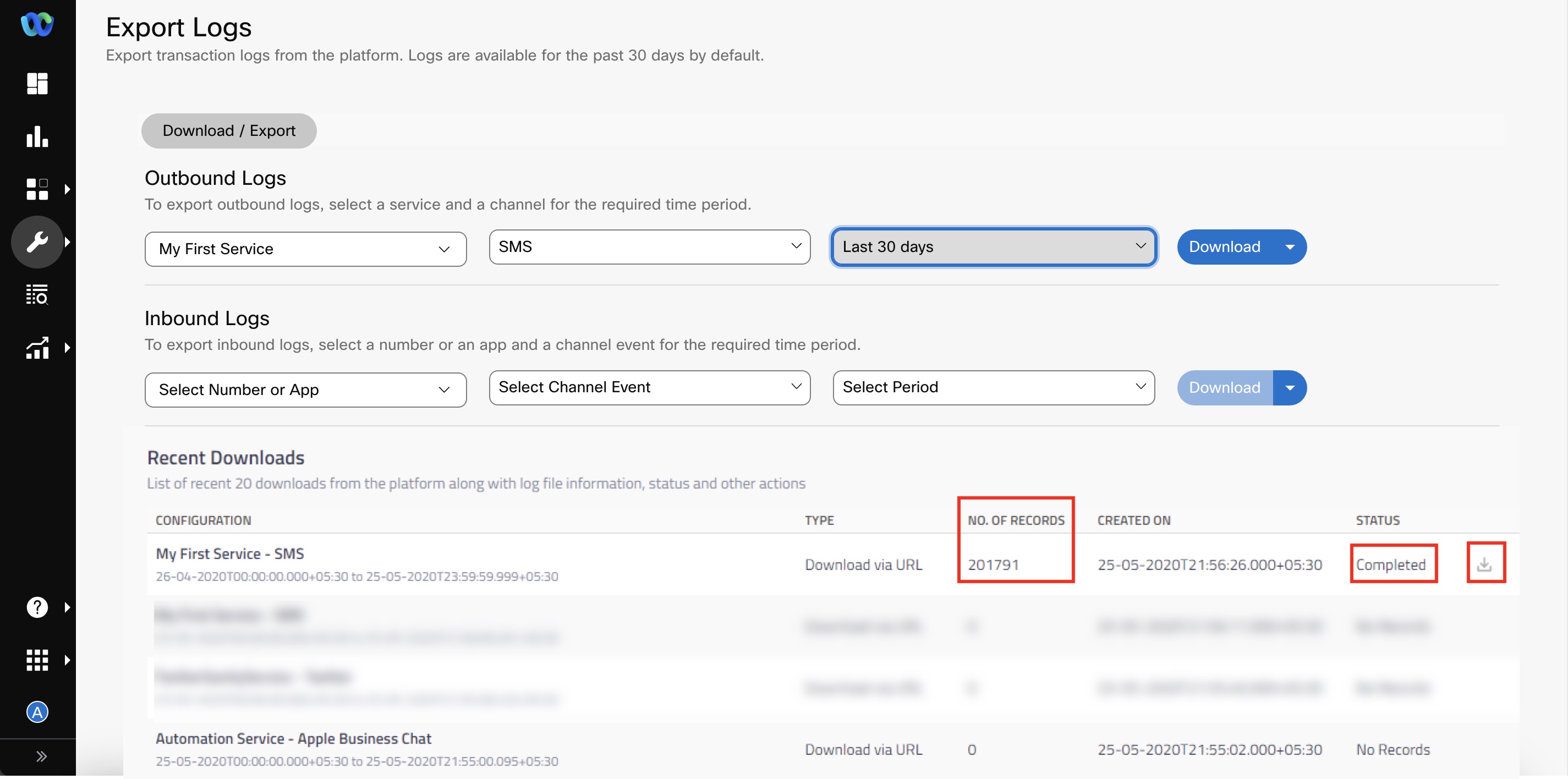
Configure one-time Export Logs schedule to SFTP/S3
Note
This feature is not enabled for all tenants by default. Please reach out to your account manager if you would like to get the 'Download and Schedule Export Logs to SFTP/AWS S3' options enabled for your tenant.
The Export to SFTP/S3 option allows you to export the logs to an SFTP or AWS S3 location.
To export the logs to SFTP/S3:
- Navigate to Export Logs pages available under Tools.
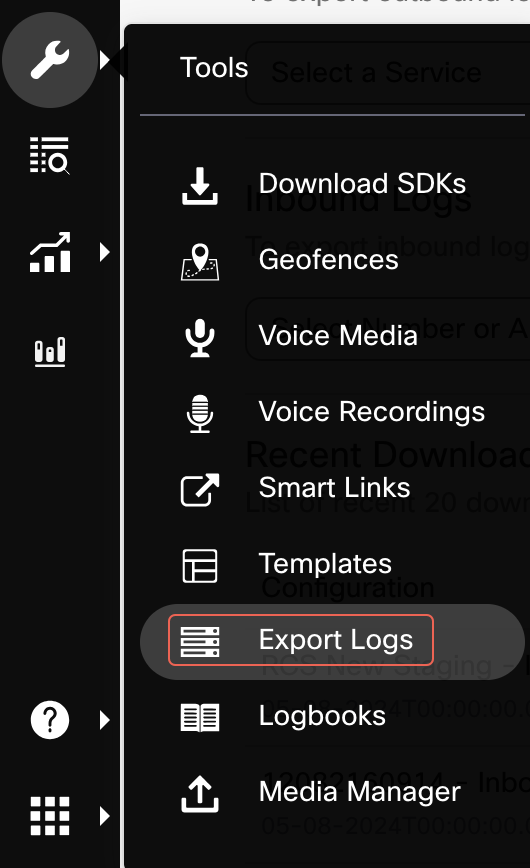
- On the Download/Export tab, click Export to SFTP/S3 under Download.

The Export logs page is displayed.
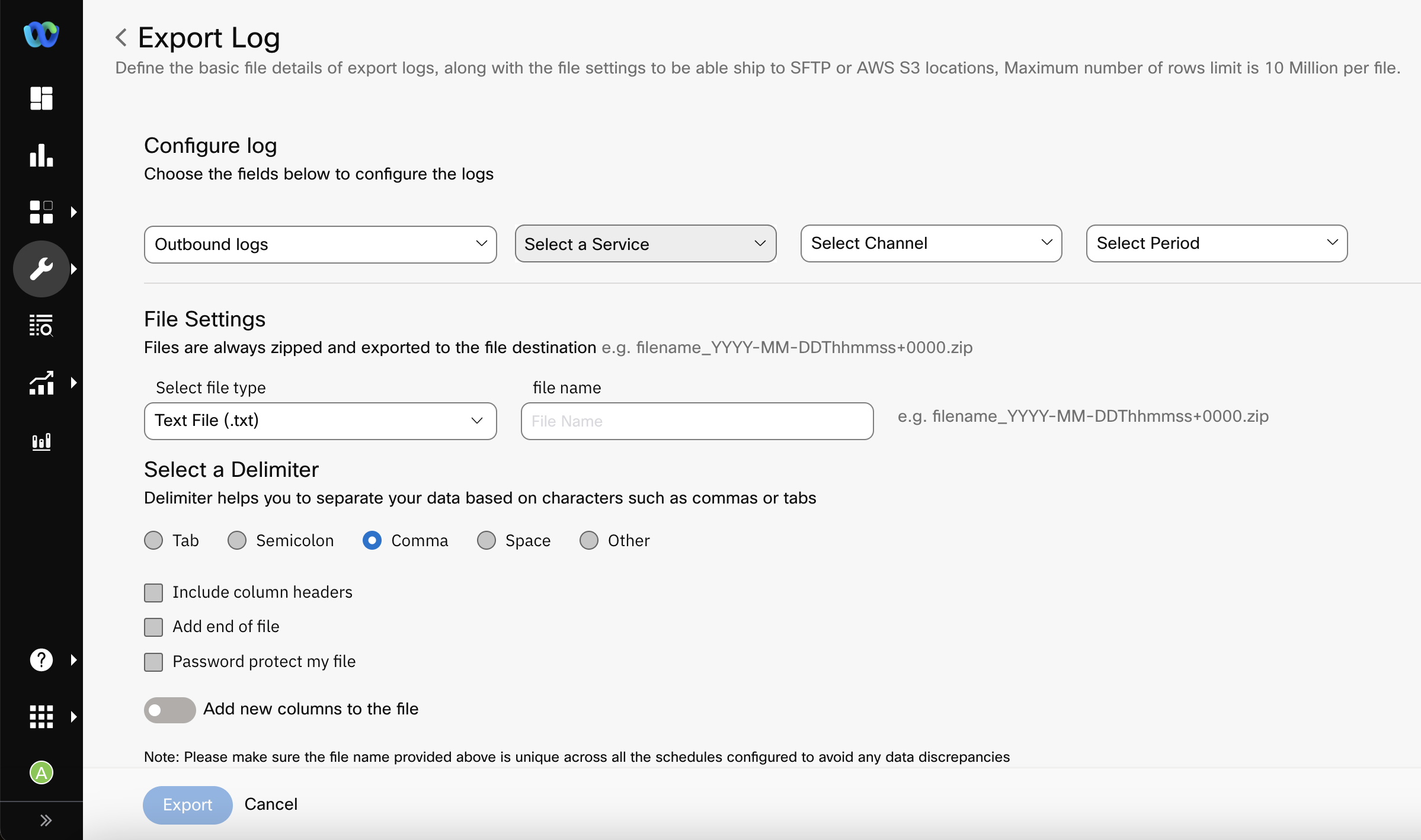
- On the Export Log page, select Outbound or Inbound logs, a Service or Number/App, a Channel or Channel Event, and the required Period.
- Under the File Settings section, select the file type (CSV File (.csv) or Text File (.txt)) from the dropdown.
- Enter an appropriate file name.
- Select a Delimiter (tab, semi-colon, space, comma, or other).
Note
If you select Other as Delimiter, enter the delimiter in the space provided.
- Select the required options for your export file from the following:
- Include column headers
- Add end of file
- Password protects my file
- Select SFTP or AWS S3 from the File Destination dropdown.
- For SFTP:
- Enter the User Name, Password, Host Name, Port Name, Path Name.
- Enter File Export Notify URL.
- Enter the email address in the Notify on Email textbox.
- Click Upload to upload the private key (example: AWS-based Open SSH key files like rsa512.ppk, rsa256.ppk, ecdsa521.ppk, ecdsa384.ppk, ecdsa256.ppk, ed25519.ppk, ECDSAprivate.ppk, EDDSA255private.ppk), if applicable.
- For AWS S3:
- Enter the User Name, Bucket Name, Access Key, Secret Key, and Region.
- Enter File Export Notify URL.
- Enter the email address in the Notify on Email textbox.
- For SFTP:
- Click Export.
You will be redirected to the Download / Export tab, and you can see a new entry created in the ‘Recent Downloads/Exports’.
Here are the various statuses that appear in relation to the options selected, while performing the export operation:- Pending: The status of export may show Pending depending on the number of recent logs. After a few minutes, the status is updated to In-progress.
- Exported: The status changes to Exported after the logs have been exported to the desired location. Sometimes, you may see a Failed status denoting the logs failed to export to the destination. This can happen because of faulty destination credentials or system errors. Try again with correct credentials. If the issues persist, reach out to the Webex Connect support team.
Note
If you select multiple services, or channels the time period for getting the logs is restricted to 24 hours i.e. you can choose only 24-hour periods in any last 30 days.
If you want to configure a scheduler to export logs to your desired SFTP or AWS S3 location on a regular frequency, you can use the 'Schedule Export' section.
Schedule Export
The Schedule Export tab enables you to view the list of log files that are scheduled for export. You can also create a new schedule, enable/disable the status of an existing schedule, manage/delete existing schedule, or view logs for executed schedules.
Note
The Schedule Export feature is a paid add-on and may not be enabled for your tenant by default. Contact your account manager if you want to enable this feature.
To add a schedule export log:
-
Navigate to Tools > Export Logs > Schedule Export.
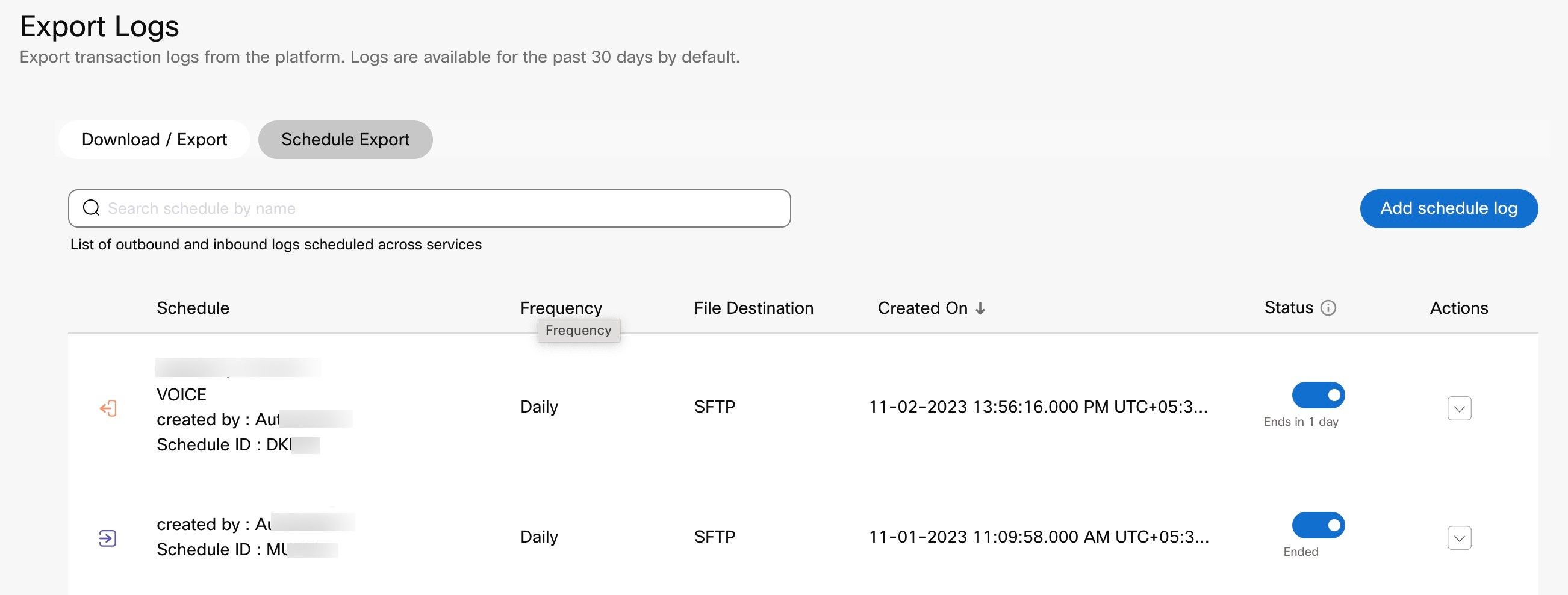
Schedule Export
-
Click Add schedule log to go to the Schedule Export Log page.

Schedule Export Log
-
Select if you want to schedule export for an Inbound log or an Outbound log or an Outbound Webhook Failed Notification log:
- For Outbound logs, do the following:
- Select Outbound logs.
- Select the required service(s). You can select one or more services per schedule. You can also select All Existing & Any New in the services(s) dropdown. If you select All Existing & Any New, all existing services and any new service that you create after the schedule will automatically be included in the next schedule.
- Select the required channel(s). You can select one or more channels. Select All Channels to include all the channels for selected services.
- For Inbound logs, do the following:
- Select Inbound logs.
- Select the required number or app. You can select one or more numbers or apps per schedule. You can also select All Existing & Any New in the number or app dropdown. If you select All Existing & Any New, all the existing numbers or apps and any new number or app(s) that you create after the schedule will automatically be included in the next schedule.
- Select the required channel event(s). You can select one or more channel events. Select Select All to include all the channel events for selected numbers or app(s).
- For Contact Policy, do the following:
- Select Contact Policy.
- Select the required Consent Group Name. You can select one or more Consent Group Names. You can also select All Existing & Any New from the dropdown. If you select All Existing & Any New, all existing services and any new service that you create after the schedule will automatically be included in the next schedule.
Note
If the Contact Policy is provisioned for a tenant, that particular tenant will have Contact Policy as one of the log options.
- Select File Type (.csv or .txt) from the dropdown. The Contact Policy log will only support the .csv file type.
- Select the Delimiter (tab, semi-colon, space, comma, others-user input). The Contact policy log will only support the default delimiter comma.
- For Outbound logs, do the following:
Note
If the Contact Policy is provisioned for a tenant, that particular tenant will have Contact Policy as one of the log options.
You can select All Existing & Any New from the Select a Consent Group dropdown. If you select All Existing & Any New, all existing and newly added enabled/disabled groups will be automatically included in the schedule.
- Select the required Period.
- Select File Type (.csv or .txt) from the dropdown.
- Enter Filename. Duplicate file names for export log schedule are not allowed. If the File Name is already used, try a different filename.
- Select the Delimiter (tab, semi-colon, space, comma, others-user input). Delimiter is the character that separates the fields in the file.
- Select the required options for your export file from the following:
- Include column headers - Select this if you want to include column names at the start of the file, if not enabled the file will directly start with column values.
- Add end of file - Select this to add end of file.
- Password protect my file - Select this to enable password protection to the file. Enter the Password to use to open the file.
- Add new columns to the file - Select this to add additional columns to the file. Select the columns you want to add from the dropdown.
Note
Only the following required options are available for file exportation when the Contact Policy log is configured:
- Add end of file
- Password protect my life
- Under Export Schedule section, Select Frequency (Daily, Hourly) from the dropdown. If you have selected All Existing and Any New or if you have configured schedule with multi-select then the frequency is reduced to only support Hourly.
- Enter Offset Days. For daily, the allowed offset is -7 to 0; for hourly, the allowed offset is 0 to -71.
Note
Every day the log file is exported between 0000 hours to 0100 hours. When an offset is set, logs of the previous day are exported as per the offset specified.
- Select Schedule Ends (in 1 day, 7 days, 15 days, 30 days, custom or do not expire) from the dropdown. By selecting custom, you can choose a particular day and time when you want the schedule to end.
- Select Add empty file when no records are found, option if you want to add a blank file in case of no records.
Note
The validity of do not expire schedule type would be 15 years.
Note
You can configure log selection based on service and channel for outbound logs, and based on number or apps and events for inbound logs. However, each schedule can only be set once. If you attempt to schedule the same configuration again, an alert message will appear: "Same log configuration already exists with schedule.
Note
Only the Tenant Owner can configure the export logs schedule.
File Format
The file format for Schedule Export Log – if the multi-select option is enabled for your tenant, the file formats are as follow:
For Outbound Logs, consider a schedule configured at hourly intervals.
- _.zip
- _1.csv
For Inbound Logs, consider a schedule configured at hourly intervals.
- _.zip
- _1.csv
Note
You can configure maximum of 10 schedules by default. Please reach out to your account manager, if you would like to get this increased for your tenant.
File Destination (export)
You can export the file to a specified SFTP or AWS S3 by selecting a new location.
To provide the file destination:
- In the File Destination dropdown, select SFTP or AWS S3.
- If you selected SFTP in the previous step, enter the following details:
- User Name
- Password
- Host Name
- Port Name
- Path Name
- file export notify URL
- Notify on email
- If you selected AWS S3 in the previous step, enter the following details:
- User Name
- Bucket Name
- Access Key
- Secret Key
- Region
- file export notify URL
- Notify on email
You can also provide an email (recommended) to get a notification email for the file export. You will be notified about any failures also on the same email id.
Note
A notification via email is sent 7 days and 1 day prior to the scheduled end date.
Schedule Export Logs
The Schedule Export Logs displays a table with columns such as Schedule, Frequency, File Destination, Created, Status (Enable/Disable), and Actions.

For each log schedule (row item), the information is shown as per the column along with a dropdown button to Manage, View Logs, and Delete Options.
- Click Actions > View Logs to view the logs in a tabular format.
The table contains fields such as File Name, Schedule ID, File Size (KB), No. of Records, Created On, and Errors.
Schedule Export Log Usage
The following line items will be available in Usage Reports:
- Number of log schedules (only for schedule row)
- Number of files processed
- Total Size of files processed
Note
In the usage xls file, Export Logs tab has the same information or headers along with the date header. (i.e. format type, number of files processed, total size of files processed, number of schedules and date).
New Columns in Export Logs
Additional columns are added for all channels to indicate timestamps for export logs and service name, flow name, etc. However, the newly added fields will be available only in the enhanced version of the Export Log. The columns include:
- Timestamps (where sent, delivered, or read, in IS8601 format)
- Error message (where not sent or not delivered)
- Time (will be in local time-zone of the tenant)
- Existing date
- Service-Name, ServiceID, FlowId, Flow Name, etc.
Access to download logs
Users with decryption access will be allowed to download decrypted log files. Whereas, users without decryption access can download only encrypted files. The users without the decryption access can see a download button only for the encrypted log file records, but not for the decrypted log files.
Owners of the tenant can configure Schedule Export Logs. Please note logs exported through schedule are always decrypted.
Downloading SMPP Logs
To download logs via SMPP:
- Navigate to Tools > Export Logs.
- For Outbound Logs, select the Service as SMS Enterprise Service - SMPP Interface, Channel - SMS, and the Period, and then click Download.
- For Inbound Logs, select the Number or App, Channel Event - Incoming Message SMS, and the Period. Click Download.
After you click download button, the status appears as 'Pending' while the log files are being prepared. The status changes to 'In-progress' when the log files are downloaded.
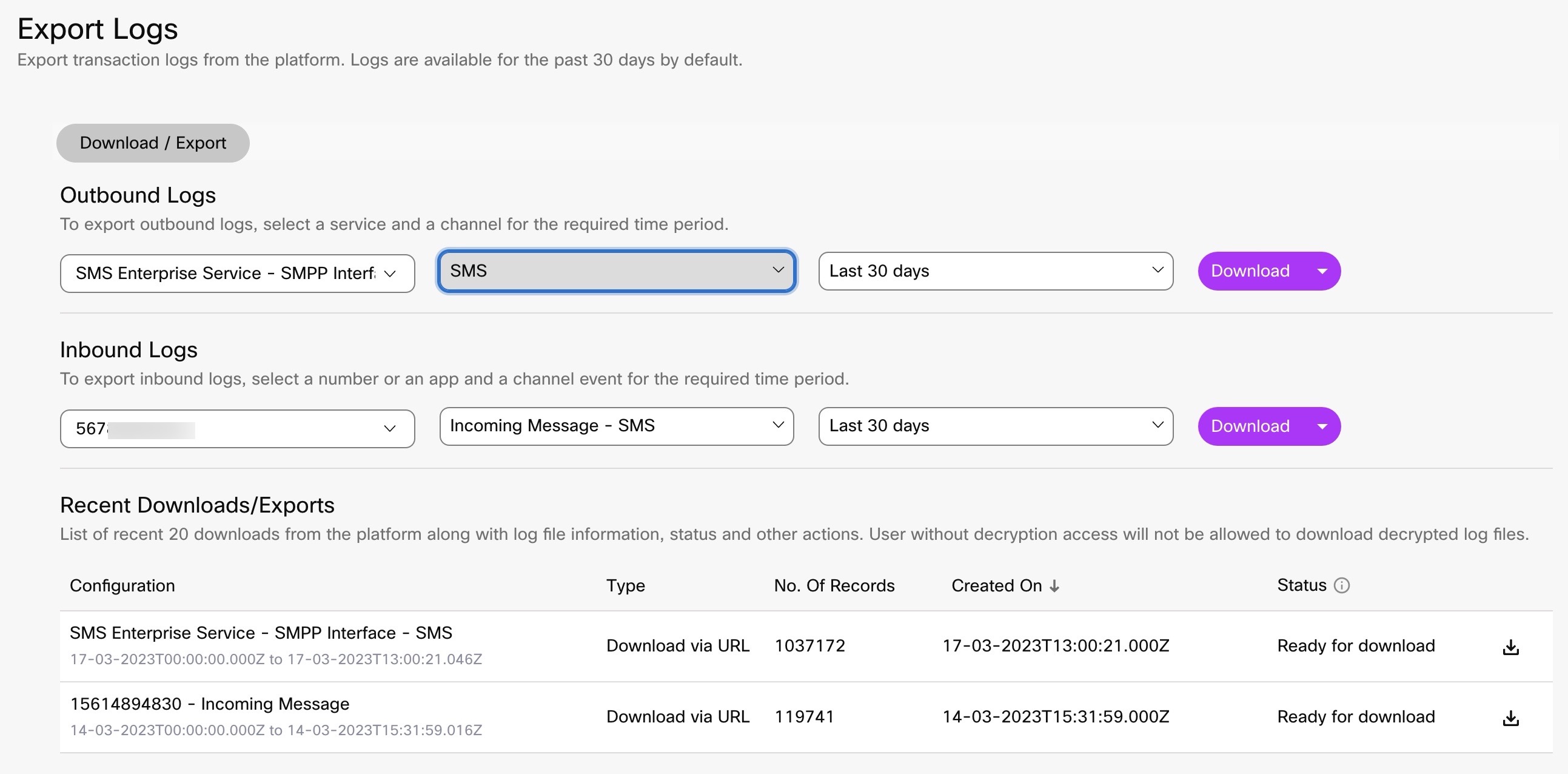
Fields in the Export Logs
The outbound logs and inbound logs contain the following fields channel-wise:
Note
Request Origin Timestamp filed is enabled only upon toggling on the feature.
The following are the common and default Outbound log fields across all channels in the Export Logs.
| Outbound Logs |
|---|
| Transaction ID |
| Correlation ID |
| Template ID |
| CRN Number |
| Source |
| Channel |
| Asset |
| Event Description |
| Current Status |
| Time |
| Timezone |
| MSISDN |
| Message |
The following are the common and default Inbound log fields across all channels in the Export Logs.
| Inbound Logs |
|---|
| Transaction ID |
| CRN Number |
| Channel |
| Asset |
| Event Description |
| Current Status |
| Time |
| Timezone |
| MSISDN |
| Message |
Channel-specific Fields in the Export Logs
The channel-specific outbound logs and inbound logs contain the following fields channel-wise:
| Channel | Outbound Logs | Inbound Logs |
|---|---|---|
| SMS | Segements [Segement counts for outbound SMS transactions for which delivery receipts have not been received by the time of exporting the logs will be logged as zero (value ‘0’)]. | Segements |
| Voice | Duration | Duration |
| In-app | User ID | Source Thread ID Date User ID |
| Push | Type Total Sent Total Submitted OS Destination Type Destination | N/A |
| Facebook Messenger | Type PS ID | Date PS ID |
| RCS | Payload | Date Media |
| WA ID Media HSM Sent Time Delivered Time Read Time | Date WA ID | |
| Apple Business Chat | ABC ID Payload | Date ABC ID |
| From Email ID Subject | Date To Email ID Subject |
Note
If +E.164 format is enabled for your tenant - all the recipient numbers will be displayed in E.164 format.
This format displays the number with a "+" followed by the country code and the phone number.
Additional fields are only available when Export Logs add-on (Bulk Download, Export to SFTP/S3, and Schedule Export) is enabled.
Add-on Fields in the Export Logs
The outbound logs and inbound logs contain the following fields channel-wise:
Common add-on Outbound fields across all the channels in Export logs.
| Outbound Logs |
|---|
| Submitted |
| Delivered |
| Failed |
| Error Code |
| Error Description |
| Message Type |
| Service name |
| service ID |
| Flow name |
| Flow ID |
| Flow transaction ID |
| Request IP |
| Channel Name |
| Asset name |
| Asset ID |
Common add-on Inbound fields across all the channels in Export logs.
| Inbound Logs |
|---|
| Transaction ID |
| CRN Number |
| Channel |
| Asset |
| Event Description |
| Current Status |
| Time |
| Timezone |
| MSISDN |
| Message |
| Segments |
Channel-specific Add-on Fields in the Export Logs
The channel-specific add-on outbound logs and inbound logs contain the following fields channel-wise:
| Channel | Outbounds Logs | Inbound Logs |
|---|---|---|
| SMS | Delivered Clicked Undelivered Failed Template type | Refer to the common add-on fields table |
| Voice | Accepted Answered Dropped Released Disconnected Trombone Release Trombone Connected FlowName FlowTid CallTid FromNumber ToNumber OfferedAt AnsweredAt EndedAt CallType MachineDetected CallDuration CauseCode CauseDescription DisplayName DisplayNumber | FlowName FlowTid CallTid FromNumber ToNumber AnsweredAt EndedAt CallType MachineDetected CallDuration CauseCode CauseDescription |
| In-App | Delivered Read Failed Message Type | Refer to the common add-on fields table |
| Push | Delivered Read Failed Message Type | Not available |
| Messenger | Delivered Read Failed Message Type Payload | Refer to the common add-on fields table |
| RCS | Delivered Read Failed Message Type Payload CarrierId MaaP | Refer to the common add-on fields table |
| Delivered Read Failed Message Type Payload | Payload | |
| Apple Messages for Business | Failed Message Type | Refer to the common add-on fields table |
| Delivered Invalid Bounced Complaint Opened Unsubscribed Failed Message Type CC BCC | Refer to the common add-on fields table |
Multiple 'To' Recipients
- You have the ability to send emails to multiple ‘To’ recipients in a single email transaction using Messaging API v2. This would require you to pass an additional parameter ‘multipleToRecipients’ to be passed as part of the request with its value set to ‘true’. When multiple email IDs are mentioned in the “Email” parameter of the “To” block, Webex Connect submits a single request to AWS SES or to SMTP server to send the concerned email to all - To, CC, and BCC. In this case, the API response will contain only one transaction ID for all recipients. Refer API reference for more information.
- When Webex Connect is used to send emails to multiple email recipients (To, CC, BCC), the message submitted count reflects the total number of emails sent (counting each of the recipient in To, CC, and BCC fields individually). These changes will reflect in the ‘Reports’ and in the ‘Usage’ sections for email transactions.
- The platform will not trigger or resume a flow, nor trigger a rule or an outbound webhook notification for incoming emails where Sender Email ID is same as the Recipient Email ID. However, details of such incoming emails will be available within Export Logs.
- For emails sent via SMTP channel, we do not support delivery tracking.
Scheduling of Export Logs across Groups and Teams
Exports logs can be scheduled at the following levels:
- Scheduling a export logs at client level - Contains transactions of client, group, and team where asset is present with flows configured.
- Scheduling a export at a group level - client/group/team - Contains transactions of client, group, and team where asset is present with flows configured.
- Scheduling a export log at a team level - client/group/team - Contains transactions of client, group, and team where asset is present with flows configured.
FAQs
- How will the export logs get updated Message status / Delivery receipts with the offset configuration?
Offset configuration can be used to get the data exported hourly or daily with offset hours or days. Example – Assume an hourly configuration of schedule export log with -1 hour of offset. A transaction between 2:00 - 3:00 PM will be reflected in export logs file generated between 4:00 – 5:00 PM. - Can one schedule export files to multiple file destinations?
One schedule can only export files to one file destination either on S3 or SFTP, but not multiple destinations as the same schedule. - How are the multiple files of the same schedule shipped to the file destination?
Files will be zipped. Multiple text/csv files will be zipped as a single zip file per schedule. - Does the schedule consider the services and assets that are in the future?
Yes, When the user chooses the “All Existing & Any New” option, all existing and new services and assets added will be considered automatically with the same scheduler configured at the respective level i.e., client/group/team. A schedule configured at the client level, as all services, will consider the existing all services + any new services added in the future at the client level. - What channels are supported currently with export logs?
Channels supported are SMS, MMS, WhatsApp, Messenger, Apple Messages for Business, RCS, Email, Push, In-app, Voice.
Updated 3 days ago
